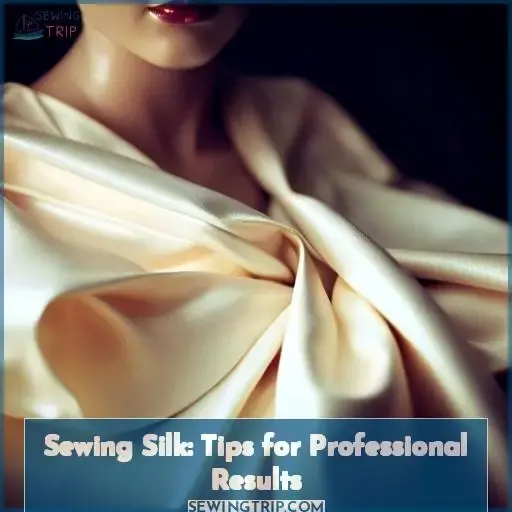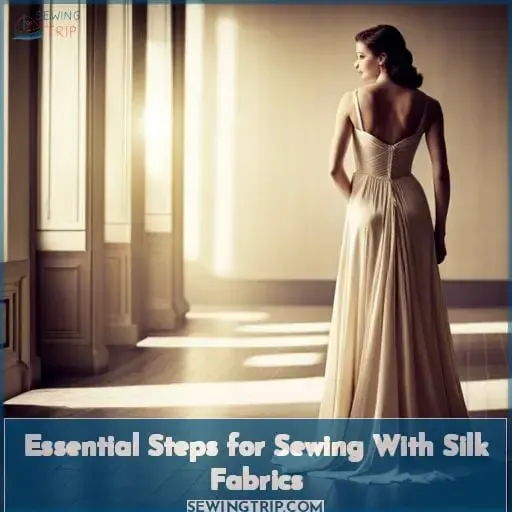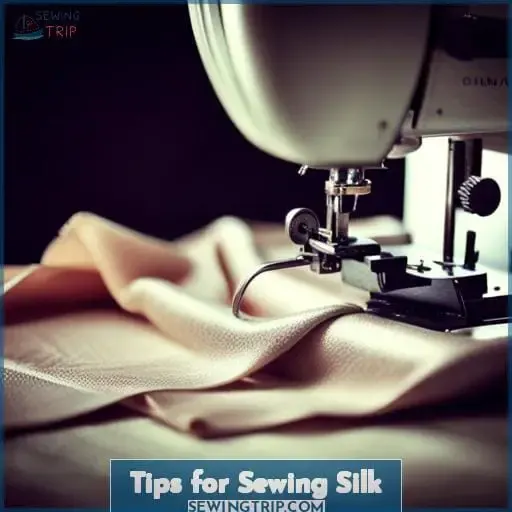This site is supported by our readers. We may earn a commission, at no cost to you, if you purchase through links.
 Choose the right needle and thread. Use a sharp, fine needle like a 60/8 or 65/9. Silk thread or very fine polyester thread work best. The thread should match the weight of the fabric.
Choose the right needle and thread. Use a sharp, fine needle like a 60/8 or 65/9. Silk thread or very fine polyester thread work best. The thread should match the weight of the fabric.
Adjust your machine settings. Decrease your stitch length and loosen tension slightly when sewing silk.
Use silk pins or extra fine pins. Regular pins can snag and damage delicate silk.
Cut carefully and on grain. Silk can shift off grain easily, so take time to ensure pattern pieces are cut accurately on the grainline.
Pre-wash fabrics. To avoid water marks, pre-wash silks before sewing if the finished garment will be washed.
Press carefully with low heat. Silk scorches easily, so set your iron to the low synthetic setting and use a press cloth.
Finish seams carefully. Silk ravels, so finish seams with French seams, zigzag or overcasting stitches.
Reinforce shoulder seams. Silk garments are delicate, so consider reinforcing shoulder seams with organza or stay tape for durability.
Baste first for trickier areas. For tricky spots like collars and cuffs, hand baste first before sewing to ensure perfect placement.
Go slowly. Sewing silk requires patience and care. Go slowly, stop to press after stitches, and check tension frequently for best results.
Table Of Contents
Key Takeaways
- Choose a sharp, fine needle and silk or fine polyester thread that matches the weight of the fabric.
- Adjust the machine settings: decrease the stitch length, loosen the tension, and slow the sewing speed.
- Carefully cut the fabric on the grainline, gently pre-wash it beforehand, and use tissue paper for stability.
- Press silk with low heat and a press cloth. Finish seams with French seams or zigzag stitches.
Essential Steps for Sewing With Silk Fabrics
When working with delicate silk, you’ll need to take special care to achieve beautiful results.
- Wash silk fabrics by hand before cutting to avoid shrinkage issues. Use a gentle soap or detergent made for delicates in cool water.
- Allow the fabric to fully air dry on a flat surface before moving forward. Do not wring or twist silk when wet, as this can stretch and distort the weave.
- Always cut silk fabrics with sharp fabric scissors or a rotary cutter and mat. Use weights to prevent shifting.
- Change your machine needle to one specifically suited for silks, such as a fine universal needle.
- Opt for silk threads or fine cotton threads in the top and bobbin. Polyester threads can snag the fibers.
- Use a fine machine stitch length, around 1.5-2 mm, so stitches don’t perforate the fabric.
- Set your sewing machine to a lower tension to avoid puckering. Check on fabric scraps first.
- Press silk with an iron set on low heat using steam and a press cloth. Avoid tugging, which can distort the grain.
Prewash Silk to Avoid Water Marks
You’ll wanna prewash that silk with some gentle soap and cold water, honey, so those pesky watermarks don’t leave their imprint.
- Use a mild detergent like Woolite or baby shampoo for prewashing
- Fill a sink or tub with cool water and add a small amount of detergent
- Allow the silk to soak for 15-20 minutes, gently swishing it around
- Rinse thoroughly in cool, clean water until all suds are removed
- Lay flat or hang to dry, do not wring or twist the silk
Following these prewashing steps helps remove any dirt, sizing, or finishes to prevent water marks later on.
Use Pattern Weights and Sharp Cutting Tools
Place those silk pattern pieces down firmly with pattern weights and cut precisely with your sharpest scissors. Avoid flimsy paper weights and dull blades. Invest in quality silk pins to prevent shifting.
Use sharp fabric shears and fresh rotary cutter blades for pinpoint accuracy. Take care when aligning pattern pieces for accurate seam allowances. Match notches and markings. Silk demands extra attention when cutting out pattern pieces prior to stitching those delicate seams.
Test Fabric Pens and Pins to Prevent Stains
I didn’t expect those darlings to sell you stains instead of stainlessness. Test fabric pens using scrap silk first. Drag slowly across the fabric. Let it dry completely before touching. Pins leave holes so opt for silk pins, placing them sparingly along seam allowances.
Choose thicker shank needles for hand sewing. Ballpoint pins work on silks prone to slipping. Test pins and thread on scraps. If stains or damage occur, try gentler options until you find the stainless sweet spot.
Choose the Right Pins and Needles
Opt for specialty silk pins and select thin, sharp needles to pierce delicate fabric without leaving visible holes. Silk pins have ultra-fine shafts that slide smoothly through fabric. Choose thin needles with sharp points; sizes 9-12 work for most silks.
Ballpoint and universal needles can damage fibers. Match lightweight thread like silk or quality cotton in a fine diameter. Adjust machine tension and stitch length for smooth sewing. Consider using tissue paper if fabric slips.
How to Sew Silk and Get Professional Results
When working with delicate silk fabric, start by properly stabilizing it with the right interfacing. Then make sure to select the best sewing needles, threads, and machine settings to avoid problems like skipped stitches, puckering, or damage to the fabric.
Use sharp, fine needles and good quality thread in the appropriate weight for silk. Set your sewing machine to a shorter stitch length and reduce the tension and foot pressure. Always test on scraps first. Take the time to pin, press, and handle the silk carefully as you sew.
With the right preparation and gentleness, you can achieve beautiful results sewing with silk.
Stabilize Silk Fabric With Interfacing
Bolster billowing silks by bonding basting-backed, body-boosting blends beneath. Align adhesive interfacing against the silks’ wrong sides, then baste before fusing fast. Woven tricots stretch with the fabric as French fusing reinforces. Frayproof facings or fuse full garment pieces for firmer finishes.
Tulle or organza backings stabilize sheers. Reinforce selectively at stress points if stiffness overwhelms. Finally, test fusibles on scraps first – improper bonding can bubble beautiful silks.
Use the Best Needle for Sewing Silk
Use the right needle for smooth stitching when sewing silk. Opt for a thin, sharp needle like a Schmetz Microtex or Bohin silk needle. Size 60/8 to 70/10 needles glide easily through silk’s delicate fibers without snagging or damaging the fabric.
Adjust your sewing machine’s stitch length down to 1.5-2mm for silk fabric. Test different thread options, but quality silk or cotton threads typically perform best. Set the machine tension slightly looser and place a sheet of paper underneath to keep the silk from slipping while you sew.
With the proper needle and settings, you’ll achieve even stitches and flawless seams on silky fabrics.
Select the Right Thread for Sewing Silk
Your sewing will look sleek when you match the thread to the silk. A thread that complements the silk creates smooth seams and hems. Use all-purpose polyester in the bobbin to stabilize. A quality 60-80 weight thread reduces fraying and pin marks.
Light pressure and short stitches prevent thread from snagging. Test colors on scraps for bleeding.
Adjust Sewing Machine Settings for Silk
The silk fabric slips easily under your presser foot as you gently lower the needle tension. Adjust the stitch length to 1.5-2mm for fine stitches that won’t snag the delicate silk. Engage the needle down function to pivot on corners without shifting the fabric.
Place tissue paper under the silk as you sew to prevent it from sticking to the needle plate. For lightweight silks, reduce the presser foot pressure so the fabric feeds smoothly. Test on scraps to find the ideal balance of tension, stitch length, and foot pressure for your sewing machine and silk fabric.
With the proper adjustments, your machine will smoothly glide through silk seams and details.
Tips for Sewing Silk
Let’s tackle silk sewing with confidence. To prevent skipped stitches, use a straight stitch plate and place tissue paper beneath the fabric to stabilize it against the needle plate. Also, learn techniques like loosening the upper thread tension to avoid unsightly puckering on this delicate material.
When sewing silk, select the right needle and thread to avoid snags and breakage. Sharp, fine machine needles easily pierce the silk fibers. Opt for lightweight, soft polyester or cotton threads that won’t shred the fabric.
Maintain even stitch length and feed rate to keep seams smooth. Go slow, and let the machine do the work. With care, patience and the proper tools, sewing silk need not be intimidating. This luxurious fabric simply requires more finesse than woven cottons or sturdy canvas.
Approach silk sewing as an artful practice in precision and gentle handling. The end result will be well worth the effort.
Use a Straight Stitch Plate for Smooth Sewing
You’d breeze through sewing slippery silk with a straight stitch plate. Its tiny hole supports lightweight fabrics and prevents puckering by keeping them stable as you sew.
- Choose the right needle, like a 70/10 microtex, for penetrating fine fabrics.
- Attach a straight stitch plate with a small needle hole to your machine.
- Use tissue paper or stabilizer under silk to prevent slipping.
- Adjust machine tension and stitch length for smooth feeding.
With the proper tools and techniques, you will achieve crisp results when sewing silk.
Place Tissue Paper Between Fabric and Needle Plate
Slip tissue paper between your silk and the needle plate so it glides smoothly without snagging. This thin barrier prevents delicate fabric from slipping down into the needle plate opening. Choose a 70/10 microtex needle for piercing the tissue easily. Polyester or cotton covered silk thread will have enough grip to feed smoothly too.
Learn Techniques to Prevent Puckering
Use a new, sharp needle – a dull needle can pierce and abrade silk fabric, causing it to pucker.
Lengthen your stitch – a longer stitch length allows the feed dogs to advance the silk more smoothly.
Increase presser foot pressure slightly – this prevents the top layer from shifting as the feed dogs move underneath.
Place tissue paper between the silk and needle plate – this reduces friction so the silk feeds evenly under the presser foot.
With the right preparation and techniques, you’ll achieve smooth, pucker-free seams when stitching delicate silk fabric.
What to Sew With Silk Fabric
Try your hand at making a flowy silk blouse to enjoy the luxurious drape. Silk is perfect for garments that drape beautifully.
| Category | Ideas |
|---|---|
| Silk Garments | Blouses, Dresses, Robes, Scarves |
| Home Decor | Throw Pillows, Curtains, Table Runners |
| Accessories | Neckties, Pocket Squares, Hair Scrunchies |
| Silk Lingerie | Camisoles, Slips, Negligees |
| Evening Dresses | Formal Gowns, Cocktail Dresses, Prom Dresses |
With proper preparation and technique, sewing silk can yield stunning results. The elegance of silk fabric lends itself to feminine, romantic, and glamorous creations. Approach your sewing silk project with patience, care, and appreciation for working with this luxurious material.
Frequently Asked Questions (FAQs)
What type of thread works best for sewing silk? While silk thread would be ideal, high-quality cotton or polyester threads can also be used. Be sure to opt for a thin, sharp needle.
Use silk, cotton, or polyester thread with a thin, sharp needle when sewing delicate silks. Smooth, high-quality thread prevents snags. Adjust tension and stitch length according to each fabric’s weight.
Conclusion
Whether you’re creating a stunning bridal gown or a vibrant quilt, sewing with silk fabric can be challenging. Take your project to the next level through proper preparation, tools, and techniques. For example, Mrs. B used fusible interfacing to stabilize her silk fabric, finding it gave her project the needed support and structure.
She also used a sharp needle and fine thread to prevent skipped stitches and puckering. Lastly, she adjusted her sewing machine’s settings to match the delicate fabric and used a straight stitch plate for even stitches.
By following these steps, Mrs. B achieved professional results with her silk project. With the right tools and techniques, sewing silk can be rewarding. But keep in mind it requires patience, practice, and understanding the fabric’s properties.
So don’t be afraid to experiment and refine your skills for the perfect project.










